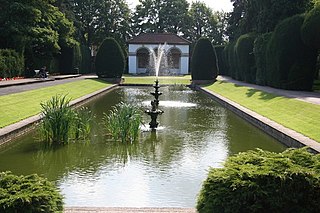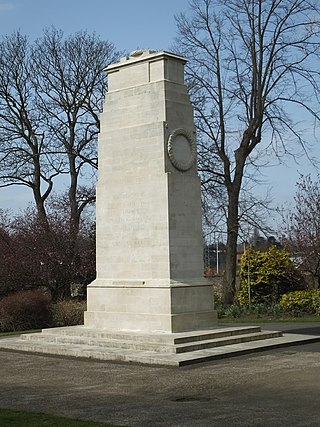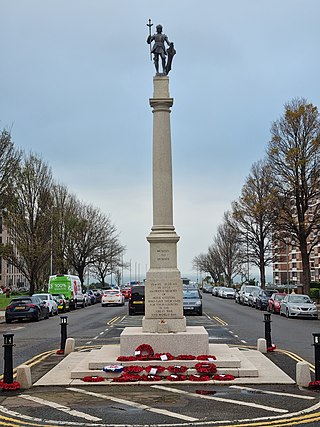
Sir Edwin Landseer Lutyens was an English architect known for imaginatively adapting traditional architectural styles to the requirements of his era. He designed many English country houses, war memorials and public buildings. In his biography, the writer Christopher Hussey wrote, "In his lifetime (Lutyens) was widely held to be our greatest architect since Wren if not, as many maintained, his superior". The architectural historian Gavin Stamp described him as "surely the greatest British architect of the twentieth century".
The year 1930 in architecture involved some significant events.
The year 1939 in architecture involved some significant events.
The year 1927 in architecture involved some significant architectural events and new buildings.
Gavin Mark Stamp was a British writer, television presenter and architectural historian.

Southampton Cenotaph is a First World War memorial designed by Sir Edwin Lutyens and located in Watts Park in the southern English city of Southampton. The memorial was the first of dozens by Lutyens to be built in permanent form and it influenced his later designs, including the Cenotaph in London. It is a tapering, multi-tiered pylon which culminates in a series of diminishing layers before terminating in a sarcophagus which features a recumbent figure of a soldier. In front is an altar-like Stone of Remembrance. The cenotaph contains multiple sculptural details including a prominent cross, the town's coat of arms, and two lions. The names of the dead are inscribed on three sides. Although similar in outline, later cenotaphs by Lutyens were much more austere and featured almost no sculpture. The design uses abstract, ecumenical features and lifts the recumbent soldier high above eye level, anonymising him.
Valve Pormeisternée Ulm was an Estonian landscape architect who became an architect. She was one of the first women to influence the development of Estonian architecture, becoming one of the country's most inventive modernisers of rural architecture in the 1960s and 1970s. She is often known as the "Grand Old Lady" of Estonian architecture.

Rochdale Cenotaph is a First World War memorial on the Esplanade in Rochdale, Greater Manchester, in the north west of England. Designed by Sir Edwin Lutyens, it is one of seven memorials in England based on his Cenotaph in London and one of his more ambitious designs. The memorial was unveiled in 1922 and consists of a raised platform bearing Lutyens' characteristic Stone of Remembrance next to a 10-metre (33 ft) pylon topped by an effigy of a recumbent soldier. A set of painted stone flags surrounds the pylon.

Marshcourt, also spelled Marsh Court, is an Arts and Crafts style country house in Marsh Court, near Stockbridge, Hampshire, England. It is constructed from quarried chalk. Designed and built by architect Edwin Lutyens between 1901 and 1905, it is a Grade I listed building. The gardens, designed by Lutyens and Gertrude Jekyll, are Grade II* listed in the National Register of Historic Parks and Gardens.

The South African War Memorial is a First World War memorial in Richmond Cemetery in the London Borough of Richmond upon Thames. Designed by architect Sir Edwin Lutyens, the memorial is in the form of a cenotaph, similar to that on Whitehall, also by Lutyens. It was commissioned by the South African Hospital and Comforts Fund Committee to commemorate the 39 South African soldiers who died of their wounds at a military hospital in Richmond Park during the First World War. The memorial was unveiled by General Jan Smuts in 1921 and was the focus of pilgrimages from South Africa through the 1920s and 1930s, after which it was largely forgotten until the 1980s when the Commonwealth War Graves Commission took responsibility for its maintenance. It has been a grade II listed building since 2012.

Spalding War Memorial is a First World War memorial in the gardens of Ayscoughfee Hall in Spalding, Lincolnshire, in eastern England. It was designed by the architect Sir Edwin Lutyens. The proposal for a memorial to Spalding's war dead originated in January 1918 with Barbara McLaren, whose husband and the town's Member of Parliament, Francis McLaren, was killed in a flying accident during the war. She engaged Lutyens via a family connection and the architect produced a plan for a grand memorial cloister surrounding a circular pond, in the middle of which would be a cross. The memorial was to be built in the formal gardens of Ayscoughfee Hall, which was owned by the local district council. When McLaren approached the council with her proposal, it generated considerable debate within the community and several alternative schemes were suggested. After a public meeting and a vote in 1919, a reduced-scale version of McLaren's proposal emerged as the preferred option, in conjunction with a clock on the town's corn exchange building.

Mells War Memorial is a First World War memorial by Sir Edwin Lutyens in the village of Mells in the Mendip Hills of Somerset, south-western England. Unveiled in 1921, the memorial is one of multiple buildings and structures Lutyens designed in Mells. His friendship with two prominent families in the area, the Horners and the Asquiths, led to a series of commissions; among his other works in the village are memorials to two sons—one from each family—killed in the war. Lutyens toured the village with local dignitaries in search of a suitable site for the war memorial, after which he was prompted to remark "all their young men were killed".

The York City War Memorial is a First World War memorial designed by Sir Edwin Lutyens and located in York in the north of England. Proposals for commemorating York's war dead originated in 1919 but proved controversial. Initial discussions focused on whether a memorial should be a monument or should take on some utilitarian purpose. Several functional proposals were examined until a public meeting in January 1920 opted for a monument. The city engineer produced a cost estimate and the war memorial committee engaged Lutyens, who had recently been commissioned by the North Eastern Railway (NER) to design their own war memorial, also to be sited in York.

The British Thomson-Houston Company War Memorial is a First World War memorial in Rugby, Warwickshire, in the West Midlands of England. It was erected by the British Thomson-Houston Company in memory of the firm's employees who left to fight in the First World War and were killed in service. Designed by Sir Edwin Lutyens, it was unveiled in 1921 and is now a grade II* listed building.

The Queen's Own Royal West Kent Regiment Cenotaph is a First World War memorial dedicated to members of the Queen's Own Royal West Kent Regiment and located in Maidstone in Kent, south-eastern England. Unveiled in 1921, the memorial was designed by Sir Edwin Lutyens following his design for the Cenotaph on Whitehall in London and is today a grade II* listed building.
The Royal Berkshire Regiment War Memorial or Royal Berkshire Regiment Cenotaph is a First World War memorial dedicated to members of the Royal Berkshire Regiment and located in Brock Barracks in Reading, Berkshire, in south-east England. Unveiled in 1921, the memorial was designed by Sir Edwin Lutyens, based on his design for the Cenotaph on Whitehall in London, and is today a grade II* listed building.

The Oxfordshire and Buckinghamshire Light Infantry War Memorial is a First World War memorial in the Cowley area of Oxford in southern England. Designed by Sir Edwin Lutyens, it commemorates men of the Oxfordshire and Buckinghamshire Light Infantry killed in the conflict; it was unveiled on Armistice Day, 11 November 1923, and has been a grade II listed building since 1972.

Hove War Memorial is a First World War memorial designed by Sir Edwin Lutyens and located on Grand Avenue in Hove, part of the city of Brighton and Hove, on the south coast of England. Hove was the site of one of the earliest recruiting events at the beginning of the war and later of several military hospitals. Over 600 men from the town were killed during the war, a quarter of them from the local regiment alone. A war memorial committee was established in 1919 and Lutyens was engaged as architect. A design was agreed in 1920 after two unsuccessful proposals; Lutyens chose the site from several options.

Wargrave War Memorial is First World War memorial in the village of Wargrave in Berkshire, south-eastern England. Designed by Sir Edwin Lutyens, the memorial was unveiled in 1922 and is today a grade II listed building.

The equestrian statue of Edward Horner stands inside St Andrew's Church in the village of Mells in Somerset, south-western England. It was designed by the architect Sir Edwin Lutyens, as a memorial to Edward Horner, who died of wounds in the First World War. The sculpture was executed by Sir Alfred Munnings.
















